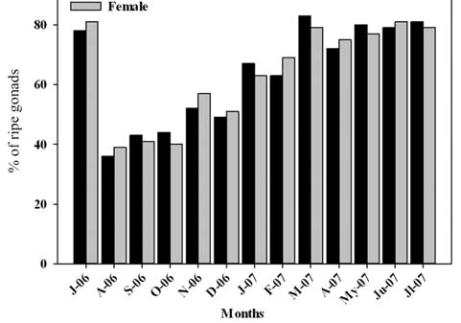Basic HTML Version




International Journal of Aquaculture 2012, Vol.2, No.10, 65
-
71
http://ija.sophiapublisher.com
68
2.5 Breeding season
The breeding season of
Oreochromis niloticus
and
Cyprinus carpio
was determined from percentages of
fish with ripe gonads taken monthly from July 2006 to
August 2007. Accordingly,
Oreochromis niloticus
and
Cyprinus carpio
with ripe gonads were caught
throughout the years; however the most intense
breeding activity occurred in January and July for
O.
niloticus
and between March and June for
C. carpio
(Figure 5).
Figure 5 The breeding season of
Oreochromis niloticus
(top)
and
Cyprinus carpio
(bottom) in Fincha reservoir as indicated
by the frequency of ripe gonads.
3 Discussions
This study demonstrates that there is a curvilinear
relationship between total length and total weight of
both fish species in Fincha reservoir. This agrees with
other studies in tropical lakes and reservoirs (Teferi
and Admasu, 2002). The regression coefficient (b) in
the relation W=aL
b
obtained in this study was not
significantly different from the cube value (b=3.2 and
2.97 for
Oreochromis niloticus
and
Cyprinus carpio
respectively) signifying isometric growth of the fish
(Chaudhuri, 1973; Naeem et al., 2010). Usually the
coefficient is expected to be close to three, since
growth in weight signifies an increase in three
dimensions while length measurements are taken in
one dimension (Tadesse, 1997). Therefore, the
relatively high value of the coefficients might be
attributed to adequate food available for the fish in
Fincha reservoir (algal biomass 15.6 µg/L and
zooplankton density 457 individual per litter). The
Fulton’s condition factor (K) expresses the relative
plumpness or degree of well-being of the fish. The
average K value of
O. niloticus
(1.82) and
C. carpio
(1.97) in Fincha reservoir is slightly lower than values
reported for the same fish species from Ethiopian rift
valley lakes (Abebe and Tefera, 1992). Generally k
value varied significantly (ANOVA, P<0.05) between
months (Figure 2). Lower values were observed
during January, March and July which seem to
coincide with the peak breeding season of the fish. In
Fincha reservoir,
O. niloticus
breeds throughout the
year showing a peak breeding season in January and
July while
C. carpio
breeds intensely between March
and June. The low K value during these periods is
attributed to the fact that breeding drains energy
profligately for the production of sperm and eggs
(Tadesse, 1997; Abebe and Tefera, 1992). In a mouth
brooder fish species like
O. niloticus
females fast
during the early stages and probably throughout the
brooding period while the males are also actively
engaged in building and guarding nests and fertilizing
females (Tadesse, 1997; Tesfaye and Tadesse, 2008).
Also, decreased condition of
O. niloticus
during the
peak breeding season in two Ethiopian Rift Valley
lakes (Ziway and Awassa) was documented with
increased reproductive activity of the fish which
causes inconsistent feeding and subsequently affects
the body condition (Admasu, 1994; Tadesse, 1988).
The Size at first sexual maturity (L
50
) of
O. niloticus
(21.80 cm for females and 24.50 cm TL for the males)
was slightly higher than those reported by other
investigators in tropical water bodies (Trewavas, 1983;
Wudneh, 1998). Apparently L
50
of
C. carpio
in Fincha
reservoir (37.50 cm for females and 24.50 cm TL for

